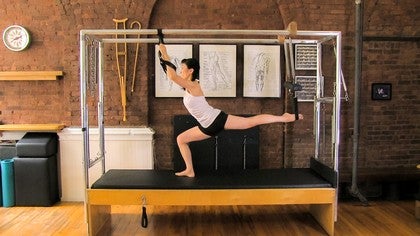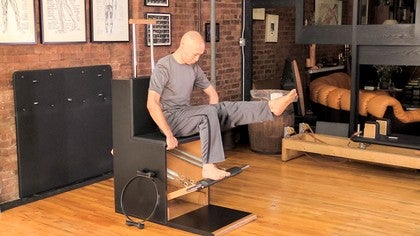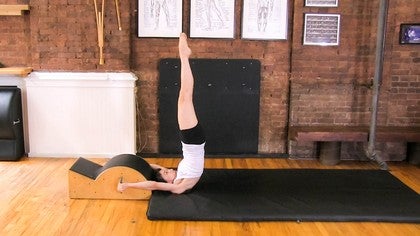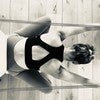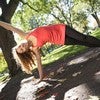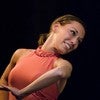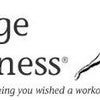Description
About This Video
Transcript
Read Full Transcript
The first exercise in the trapeze table sequence is called upper arms. It was traditionally done with the magic circle between the knees and for those people who were unable to use the magic circle or needed to do the exercise with straight leg, the trap piece was pulled out and the feet were in the trap. He, his legs extended, so almost all of the whole body exercises were only repeated three times. Corolla said this was specific to Joseph [inaudible] and we were not permitted to do any of these exercises more than three times. The second exercise in the sequence is a version of swan also called push through on the stomach. Now this is slightly changed from the version that I learned from Corolla where literally she had you hang down and stretch, but we don't do that anymore because we are now much more aware of and concerned with shoulder stabilization and so we avoid any kind of stretching or bouncing that would hyper extend the shoulder bend and stretch was done by all the clients unless they had hip, knee or ankle problems.
First double leg hip with the part parallel and the parallel position here, you want all the Metta tarsals on the bar so that they are as close to parallel to the bar as possible. The mechanics of this exercise literally are the mechanics of taking off into a jump and landing from a jump and then we move on to single leg. Everyone also was required to do single leg to address any issues of imbalance or uneven muscle development. So it's exactly the same exercise that you did with double legs only now much more difficult to center the pelvis. And then there was the hip opener for the dancers turned out in second position.
This is quite an extreme range of motion and so this was only given to the dancers, so it's the same movement. Relevate flex, Relevate plea, maintaining the turnout from the top of the leg and trying to climb all the way up on the standing hip with energy down through the standing leg. The setup is basically the roll up against resistance. It's also a combination of roll up from the mat work and teaser. It's a pure flection exercise.
So as you see, when you come up to teaser position at the top, the whole spine is rounded, thus distributing the resistance of the spring over the entire length of the spine. Unlike sitting tall and having that vertical pressure bearing straight down through your spine.
The breathing is an exercise that was based apparently by Mr [inaudible] on the Valsalva maneuver. So originally when this was done, you inhaled, as you rolled up, you held your breath as you press down with the bar, creating much more pressure inside the rib cage. But now we don't do it that way anymore because we know it's contra indicated. So we've changed the breathing pattern, but as a coordination exercise, it's excellent. The leg circles are very beautiful and thorough coordination.
They actually require a lot of brainwork. Corolla used to limit to three repetitions because she said you dancers, you could lie there all day and just circle your legs. The leg circles led directly into the Paseo [inaudible], which are more articulation of the hip and the leg and thus requiring more centering through the pelvis. Corolla had these foot straps on the side of the Cadillac, which you can see so that the standing leg used add duction to help stabilize the pelvis. So the version of the side leg circles that you go is performing now is the most advanced version. It's all turned out with the standing leg off the mat, and so there are a number of steps that you would bring a beginner client through to prepare them for this exercise.
This exercise takes a tremendous amount of concentration, control and coordination and builds a lot of strength. Now, Corolla's trap table had a spring in the center, which I don't think that Mr Pawley's had so that you could lie in the center of the table with your spine directly under the spring while doing the side leg series. And now we're moving into the pos ses sidelining which you originally would learn parallel. And the parallel passe is just like a bicycle stroke. So I think that this is an addition that Corolla made to the [inaudible] repertoire because she worked with so many dancers and loved working with dancers and this really helped the dancer build strength to stay high on their standing leg, extend through their spine and articulate through the working leg. It's a very dangerous move if you do not totally control your pelvis.
So this was only given to people who had enough technique to be able to maintain the resistance of the spring, maintain their leg alignment and of course keep their trunk and pelvis centered. No you go is going to demonstrate the preparations for the prone leg circles where both hips stayed down into the mat as much as possible. Good. And the upper body stay square to the mat. So she's going to do a Rhonda Sharman Second. Go directly to Tondo back with the hip down into the mat, the right hip, down and close together.
Second position, Rhonda Sham Teton, do two hips into the map and lower Bullock. Now reverse Tom do back second position. So these are extremely advanced exercises that were just for dancers, extremely difficult and so worth it because when you stand up and do a grand Rhonda Xom, you have an enormous strength and control. This exercise is very similar to double leg kick in the mat work working against the springs to help extend the spine good and use resistance through the arms so that the shoulders are working and integrated into the back. Arms are like big wings.
At Corollas, we use the hanging straps for support for splits and splits were done sometimes without, but usually with the trapeze and the trap piece on the old equipment was unlocked. There was no kind of locking device so that the trap piece could move and adjust to the body.
Pilates Legacy Project: Carola Trier Methods
Comments

Love it.
You need to be a subscriber to post a comment.
Please Log In or Create an Account to start your free trial.
